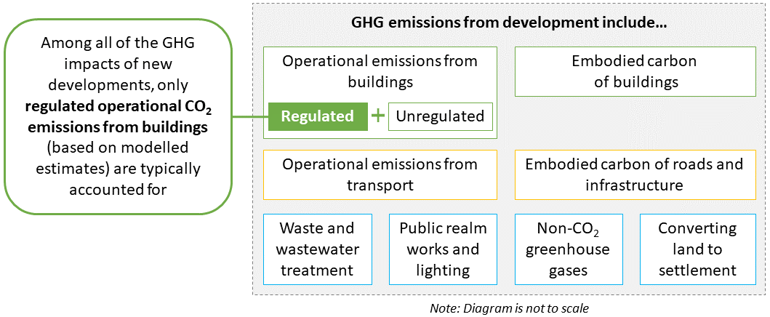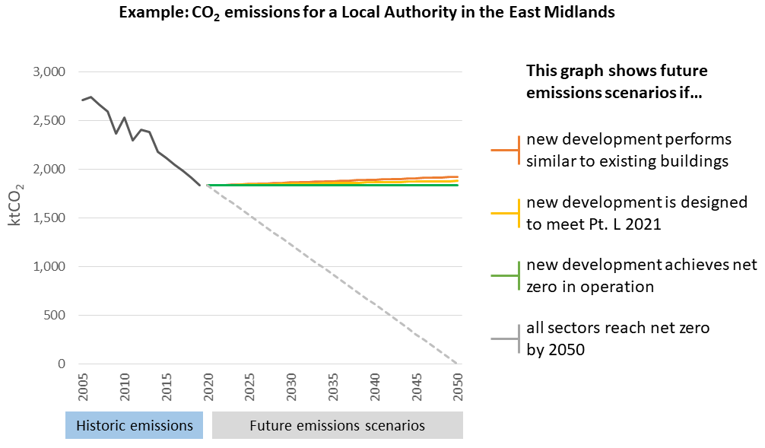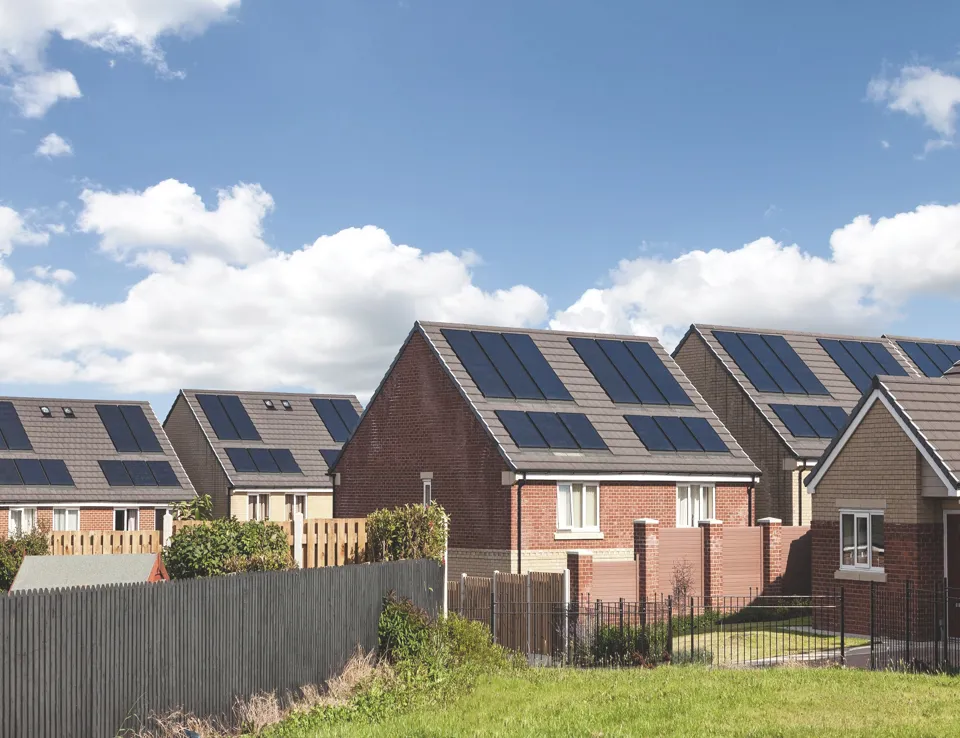Incorporating net zero thinking into your Local Plan
Local authorities are important players in the race to net zero. While the public sector is only responsible for around 3% of emissions nationwide, local authorities can have a much broader influence.1 The Climate Change Committee (CCC) estimates that councils can influence around 1/3rd of emissions within their local authority area, either directly or indirectly.2 One of the most important ways that councils can have an impact is via the Local Plan, a document that sets out policies and proposals for future development and land use.
Figure 1. Local Authorities' influence over GHG emissions (adapted from the CCC)

In their remit as local planning authorities (LPAs), a council’s main areas of influence are new buildings, spatial planning (as this impacts the ways people travel and the mix of uses/facilities in a given area), and changes of land use. LPAs can also support decarbonisation of the wider UK energy system by backing renewable energy developments and identifying land suitable for this purpose. There are also opportunities to influence emissions reductions in existing buildings via policies aimed at refurbishments, retrofits and extensions. In short, any activities that require planning permission present leverage points.
LPAs have clear obligations to tackle greenhouse gas (GHG) emissions through the local planning process. For example, the National Planning Policy Framework (NPPF) states that the planning system should ‘shape places that contribute to radical reductions in greenhouse gas emissions.’ At a local level, many councils have voluntarily announced plans to reach net zero emissions ahead of the national 2050 target.
Yet despite these national and local commitments, far from reducing GHG emissions, most Local Plans would actually see GHG emissions increase – even if they set ambitious standards for new developments. To understand why this happens, and what LPAs can do about it, requires us to re-assess the way that these policies are normally set and think differently about how buildings fit into the wider pathway towards net zero. Through Ricardo’s recent work with LPAs, we have identified two key technical barriers that prevent Local Plans from fulfilling their full climate change mitigation potential.
Problem #1: Most sources of emissions from new developments are not assessed
In the context of the UK built environment, net zero targets most commonly relate to regulated operational CO2 emissions occurring due to energy uses located within the redline boundary of a development site. That’s a bit of a mouthful – to put it in simpler terms, when energy assessments are carried out as part of the design, planning and building control process, they normally only measure some emissions from some energy use onsite.
‘Regulated’ energy use is associated with fixed fittings and services that are inherent in the design of a building, and normally present in the building before it is occupied, such as space heating and cooling, hot water, ventilation, cooling systems, and fixed lighting. (These are covered under the Building Regulations, hence the term.) ‘Unregulated’ energy use refers to everything else, such as electronic appliances, IT equipment, audio-visual equipment, etc.
However, as illustrated in the diagram below, the current approach excludes many significant sources of GHG emissions related to development.

Most of these sources are not accounted for as part of the typical planning and Building Control process, and are therefore difficult for the Government, LPAs or other stakeholders to influence. The good news is that embodied carbon, which is often the largest source of emissions from new development, is starting to receive much greater focus within the construction industry.
But, what about the rest?
To give one example: Our modelling shows that, for some domestic developments, the cumulative operational emissions from residents’ petrol and diesel cars can be even higher than those of the buildings themselves. If you’re a local authority who has declared a climate emergency and set a net zero carbon requirement for new buildings, but haven’t sought to address transport emissions as well, your area-wide emissions are going to keep going up, rather than down. This is a major missed opportunity.
Arguably, there’s an even bigger problem:
Problem #2: Local Plans don’t really address existing sources of emissions
To date, most LPAs that have set energy or CO2 performance standards in their Local Plans only apply these to new buildings. This approach will, at best, mitigate the increase in emissions that would occur if the buildings were constructed to a lesser standard, as shown on the chart below. Usually, Local Plan policies do not contain any other measurable targets for reducing existing GHG emissions. However, if the entire UK is to reach net zero by 2050, it will be necessary to introduce much more ambitious policies aimed at tackling existing sources of emissions.

Note: This graph is intended to provide a rough estimate of the scale of impact from new housing development, and the scale of this impact compared to other sources, if all other variables are held constant.
As discussed at the start of this blog, the planning system can influence existing sources of emissions – but it will require a paradigm shift in the way that climate change related planning policies are set. In addition to setting high standards for new buildings, actively supporting GHG reductions via the planning system will involve using all available levers to:
- Improve the performance of the existing building stock – recognising that only certain refurbishments, conversions and extensions will come through the planning system
- Strongly promote refurbishment over “demolish and rebuild”
- Safeguard existing carbon sinks and greenfield sites
- Over time, reconfigure the design of the public realm and road networks, and change the mix of uses in neighbourhoods to reduce reliance on private vehicles
- Proactively encourage a step change in deployment of renewable energy technologies
- Minimise indirect supply chain emissions and resource demands and apply circular economy principles when considering waste reduction, material selection, etc.
Conclusion
Aligning Local Plans with net zero ambitions is a huge challenge. The issues described in this blog are just two of many, but they are important. In many cases, there are no standard assessment methods for estimating the scale of those wider sources of emissions, and no way of drawing them together to assess the overall impact. There are also discussions to be had about who is responsible for reducing them and what the best regulatory approach would be. In future blog posts, we’ll be addressing some of these challenges.
Ricardo is proud to be at the forefront of research on this topic, with a team of experts across building design, planning policy, transport, GHG inventories, energy modelling and environmental assessments. Our hope is that, by looking at the bigger picture, we will start to see Local Plans that truly start to contribute towards the ‘radical reductions in emissions’ that are so urgently needed.
If you’d like to discuss ways to align your Local Plan with a net zero future, get in touch.
Footnotes
1. BEIS (2022). UK local authority and regional greenhouse gas emissions national statistics. Available at: www.gov.uk/government/collections/uk-local-authority-and-regional-greenhouse-gas-emissions-national-statistics
2. CCC (2020). Local Authorities and the Sixth Carbon Budget. Available at: www.theccc.org.uk/wp-content/uploads/2020/12/Local-Authorities-and-the-Sixth-Carbon-Budget.pdf










